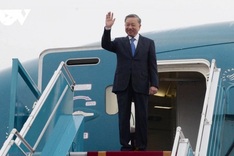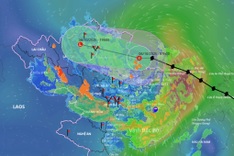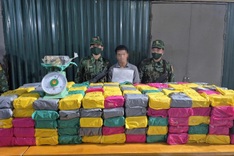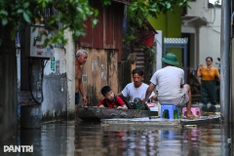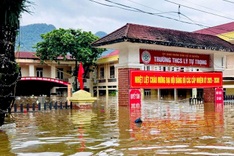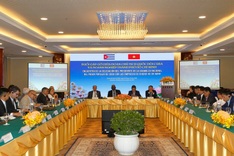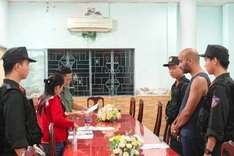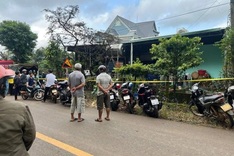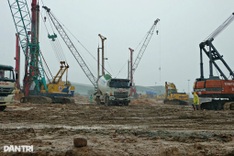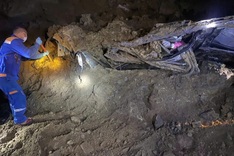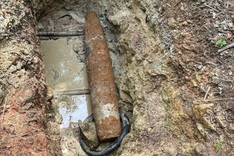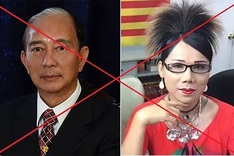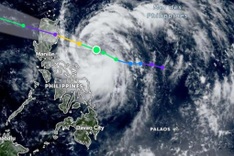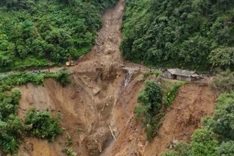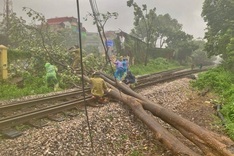HUE, Vietnam – During the Vietnam War, American bombers dropped millions of tons of ordnance on the country, exceeding the Allied bombardment during World War II.
 | |
| Do Thien Dang, a mushroom farmer in Quang Tri province lost his lower limbs when he stepped on a piece of unexploded ordnance. |
Artillery units from both sides fired countless rounds of heavy munitions. Massive amounts of other explosives, from land mines to mortar rounds, also were expended in the conflict.
The munitions still haunt Vietnam. Since fighting stopped more than 30 years ago, more than 100,000 Vietnamese have been killed or injured by unexploded ordnance.
“The war has never ended for them. I had no idea of the incredible amount of unexploded ordnance. It was a real eye-opener,” Army veteran George Whitehouse said.
Whitehouse and a group of Americans are on a weeklong tour of Vietnam sponsored by the Vietnam Veterans Memorial Fund.
On Thursday, they toured Quang Tri Province, which has one of the highest concentrations of unexploded ordnance in the country, with an estimated 80 percent of the land affected.
The delegation, including Spurs chairman Peter Holt and retired Gen. Barry McCaffrey, saw firsthand the horrific after-affects of a bloody conflict that for United States combat forces ended in 1973.
“While he was farming, he was unlucky enough to have had an accident. Some said a mortar, others a cluster bomb,” said a translator for Tran Dinh Toa, a peasant who was blinded and maimed.
Earlier in the day, the group members met a stoic farmer named Do Thien Dang, also crippled by left-behind munitions.
“He was injured in 1980. The result was he lost both legs, but he was lucky. He got married to a woman and has three daughters who help him,” the translator said.
Since 2001, Toa, Dang and dozens more here in a region that bordered the demilitarized zone between North and South Vietnam have been helped by the American veterans' organization.
“Project Renew was designed to reduce deaths and injuries by education, and by clearing up bombs and mines. The children can now identify virtually every type of ordnance,” said Chuck Searcy, the VVMF's representative in Vietnam.
“Now, we can see results. When we started, there were 40 (to) 50 accidents a year. In the last couple of years, the number of accidents has been reduced to about 10,” he said.
In 2009, project teams cleared 42 acres of explosives, removing 1,300 devices. More than 300 more explosives were collected by quick response teams, according to the annual report.
Dealing with the past
The project, which is run by Vietnamese and works in close collaboration with government officials, also provides prosthetic devices and micro loans to accident victims.
Dang, for example, has been growing mushrooms for market since 2003.
Toa is chairman of the local association of the blind. Its toothpick business was aided recently by Project Renew's donations of machinery and a new building.
Hoang Nam, a Quang Tri Province official who runs Project Renew, now works closely with American veterans, despite his family's past.
“I had three uncles who were fighting for the north and were killed in the war. It's the same for every family here in the DMZ area. Some families had people who fought for the south, and the north,” he said.
“But you cannot live in the past. In Vietnam, if we could not live with the bitter past, we could not survive. We had many wars with the Chinese, the French and the Americans,” he said.
After a lunch of squid, swordfish, prawns, pork, boiled eggs and rice with local government and military officials, the veterans got a close look at some explosives found recently in An Hung Village.
“This is a cluster bomb. It's one of the most dangerous. They were dropped from planes,” warned Dinh Ngoc Vu of Project Renew's quick response team, pointing out a round rusty object.
The cluster bomb and two M-79 grenades had been unearthed by a man digging around banana trees. All three devices later were detonated. Many more likely will be found.
“There was a huge World War I-like battle here (in the early '70s) with hundreds of artillery weapons firing at each other, and when they pulled out, they left hundreds of defective or abandoned rounds,” said McCaffrey, who was badly wounded in Vietnam.
Beauty and innocence
Earlier in the day, the delegation of Americans attended the dedication of a new rural elementary school that was built with $50,000 provided by the VVMF.
With nervous mobs of flightless ducks and the occasional unflappable water buffalo passing by the schoolyard, the veterans received a gala welcome from the excited children and local officials.
“They've seen one or two Americans before, but never a large group,” said Lung Viet Huag, a teacher. “This is a special day for them. They have a new school.”
As the children danced in makeup and costume, David Stone, who served here with the Army in 1966 and 1967, reveled in the beauty and innocence of the moment.
“I think this is the most gorgeous thing. I didn't see any of this the last time I was here,” he said.
“I did see kids and they were just as cute as they are now. We gave them chocolate from our C-rations but they always wanted the cigarettes. And it blew my mind. It wasn't for someone else. They would smoke them.”

